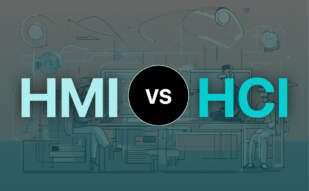HCI stands for Hyper-converged Infrastructure. It is a software-centric architecture that tightly integrates compute, storage, and virtualization on x86 hardware. HCI addresses challenges in heterogenous environments and utilizes unified management to pool resources effectively.

For those exploring alternatives to Hyper-converged Infrastructure, options include GUI, OIT, SCADA, PLC, MES, DCS, Tungsten, LED, HMI.
GUI
Enter the grand world of GUI (Graphical User Interface), a transformative realm that catalyzed the dialogue between man and machine into an intuitive visual language. Codified through a gallery of impactful symbols, visual metaphors, and supportive pointing devices, GUI carries the resounding legacy of our modern digital era.
GUI Top Features
Some outstanding features of GUI include:
- Inventive Legacy: Reflecting the genius of pioneers like Vannevar Bush, Douglas Engelbart, and Alan Kay, GUI revolutionized human-computer interaction.
- Intuitive Interface: Host to an array of visual icons and a virtual desktop screen, GUI rendered complex operations a user-friendly experience.
- Flexible Usage: GUI’s historical trajectory from the Apple Lisa and Macintosh systems to IBM PCs underlines its flexible application overall computing domains.
| Features | Description |
|---|---|
| Emphasis on UI and UX | Encourages user-friendly interactions, enhancing the overall digital experience. |
| Touch-sensitive LCDs | Emphasizing the feasibility of integrated controls, touch-sensitive LCDs expand a product’s lifespan and decrease its size. |
| WIMP paradigm | The Window, Icon, Menu, and Pointing device paradigm is a legacy of GUI ushering into the domain of gaming. |
GUI Limitations
- Resource Consumption: Extensive use of GUI can lead to high memory and processing demands.
- Lack of Standardization: Designs can greatly vary from one system to another, creating inconsistencies in user experience.
GUI Pricing
The beauty of GUI lies in its universality. This fundamental aspect of our computing systems comes as a standard feature, encouraging widespread application across multiple platforms without additional financial obligations.
GUI Use Cases
Use case 1: Web and Mobile Applications
GUI’s profound impact shows in the development of web and mobile applications. Its intuitive design and usability have massively enriched user experience and interaction with these applications.
Use case 2: Gaming
Windows, icons, menus and pointing device paradigm have been instrumental in gaming interfaces, drastically enhancing user experience due to GUI’s intuitive usability.
Use case 3: Workstations
Professional workstations have greatly benefitted from the GUI, simplifying complex tasks and operations into user-friendly exercises.
OIT
The OIT, or Operator Interface Terminal, forms a crucial link between users and the backend technology. Integrated with controller internal registers read/write functionality, it is engineered to provide a seamless and interactive communication interface.
OIT Top Features
- Message Request Register (MRR): This constantly monitored feature allows for automatic screen displays and execution of special functions like sending content to optional serial printers.
- Multiple Language Support: Enhancing operational flexibility with diverse user landscapes.
- Status Register: This shared channel conveys messages, alarms, errors between the OIT and the controller.
- Key Coils: They facilitate OIT-controller keypress data transfer, helping to distinguish between function key coils and control key coils.
| Function | Description |
|---|---|
| Current Message Register (CMR) | Programmable for information display on OIT’s current screen. |
| Register Monitor | Places the OIT in a position to monitor/update the controller’s memory; can manage up to 25 monitors per OIT screen. |
| Linear scaling on registers | Makes data readable for operators. |
OIT Disadvantages
- Lack of user-friendly approach in some industries.
- Increasing favorability for readability at a glance, glove-hand operation, may decrease the use of keypad operation.
OIT Pricing
The cost of OIT services from Boulder OIT ranges from $115/month for a private cloud server to $85/month for VM CPU. Additional charges for VM Memory and VM Storage apply, as well as for after-hours consulting services.
OIT Use Cases
Industrial Applications
OIT is often utilized in industries that require temperature, time, and pressure displays on ovens, autoclaves, and clean-in-place systems. This use case caters equally to both batch and continuous manufacturing.
Robotics
In the realm of robotics, OIT sees frequent application in monitoring and controlling various parameters.
Warehousing
In warehousing, OIT aids in processes like inventory management and logistical operations.
SCADA
Delve into the universe of SCADA, or Supervisory Control and Data Acquisition, a sophisticated computer application that stands as a centralized monitor and control system for a complete network. Predominantly used across a spectrum of industries, SCADA reshapes complex industrial processes, measures trends, detects, and troubleshoots problems.
SCADA’s Stellar Features
- Automates Complex Industrial Processes: Goes beyond simple automation, providing intricate management of industrial procedures.
- Highly Compatible and Versatile: Used across myriad sectors like oil and gas refining, water and waste control, energy, transportation, and telecom.
- Network of Interconnected Nodes: Incorporates Remote Terminal Units (RTUs), sensors, control relays, SCADA master units, and communication channels.
- Rooted in Future Tech: Plans for integration with 5G networks, quantum computing, artificial intelligence, and edge computing.
| Components | Functions |
|---|---|
| Discrete and Analog sensors | Collects discrete information from equipment and monitors environmental live values respectively. |
| RTUs and PLCs | Allows for efficient, secure monitoring and site control. |
| Human Machine Interface | Serves as a master station, processing data and communicating it effectively to human operators. |
SCADA Downsides
- Cybersecurity Concerns: As SCADA systems become more interconnected, they potentially expose increased risk to security breaches.
- Legacy Systems: Older SCADA systems may lack scalability and interoperability and may offer limited support.
- High Setup Cost: Programmable Logic Controllers (PLCs) can result in high initial expenses.
SCADA Use Cases
Use case 1: Energy Sector
Optimizes energy management, efficiency and enables detailed performance monitoring.
Use case 2: Manufacturing
Augments productivity, enhances process control and bolsters safety measures.
Use case 3: Water and Waste Water Management
Fosters efficient and environmentally friendly processes via precise control and regulation.
PLC
Emerging in the 1960s as a compact, high-speed and dynamic alternative to monotonous hardwired relays and timers, PLCs (Programmable Logic Controllers) have established their vital role in the manufacturing arena.
PLC Top Features
- Bolstered by the introduction of inexpensive microprocessors in the 1970s.
- Experienced transformative growth with the introduction of third-party software packagesin the 1980s, hence bringing down the cost of programming devices.
- Adopts the IEC 61131-3 Standard, marking a milestone for all PLC software, thus easing the understanding of programming language.
- Birthed the Human-Machine Interface (HMI) in response to demand for interactive terminals, thereby redefining the user experience.
- The advanced capabilities of current PLCs stem from leaps in processor and memory technology paving the way for Internet big data and artificial intelligence on the factory floor.
| PLC components: | CPU with processor, memory, Input/Output modules, power supply |
| Optional-additional components: | network interfaces |
| Core of programming unit: | Power supply/rack, Central Processing Unit, Input/Output section |
PLC Disadvantages
- Dependency on skillful workforce due to inherent complexity in troubleshooting.
PLC Use Cases
Use case 1
Automotive Industry: Essential for the operation of robotic arms in car manufacturing.
Use case 2
Airport Management: Crucial component in controlling airport runway systems.
Use case 3
Traffic Management: Integral part in the control of traffic signal systems.
MES – Manufacturing Execution Systems
At the heart of modernized manufacturing lives the MES – Manufacturing Execution Systems, morpheus of raw materials into polished finished goods. A herald of information in real time, it amplifies decisiveness, enlarges production output, and reigns over all entities in the manufacturing universe.
Best Features of MES
- Product Lifecycle Management: A comprehensive records of products from inception to retirement.
- Order Execution and Dispatch: A master marshall that guarantees your commands are impeccably carried out.
- Downtime Management: Minimizing idle time, maximizing efficiency.
| Materials Tracking: | Accurately know how components flow through your production cycle. |
| Product Quality: | Supreme guard of quality, ensuring flawless finished goods. |
| As-built records: | A transcriber of history, capturing every crucial detail of the manufacturing journey. |
Potential Downsides of MES
- High implementation cost, ranging from $375,000 – $1.2 million.
- Requires optimal integration with existing systems – ERP, PLC, PLM, CMMS, WMS, and HRMS.
- Custom-built MES solutions might be needed for advanced data protection.
MES Pricing
Like the commission of a Maestro for an opera, the deployment of MES requires a considerable investment, usually between $375,000 and $1.2 million. Yet, the sweet resonance of streamlined operations and enhanced productivity could prove it to be a worthwhile expense.
MES Use Cases
Use Case: Regulated Industries
In a fortress of laws and standards that regulated industries like food, beverage, and pharmaceuticals reside, MES proves its worth. By capturing data, processes, outcomes in an ‘as-built’ record, MES proves to be the unyielding protector of industry norms and quality standards.
Paperless Workflow
MES morphs your manufacturing space into a clean, efficient ecosystem that fosters growth. By incorporating paperless workflow activities and enabling real-time tracking, it brings about the dream of manufacturing operations traceability.
Quality Control for Regulatory Compliance
MES emerges as a beacon in domains craving regulatory compliance. Its virtues of improved quality control, decreased downtime, and fortified product tracking position it as an indispensable asset in these landscapes.
DCS
At the heart of modern day automation and control lies the Distributed Control System (DCS). This robust functionality allows for the decentralized regulation of larger facilities, with its influence anticipated to propel the global DCS market to an estimated $23.37 billion by 2025. With its broad range of utilities, DCS is fast evolving into the preferred choice for industries seeking improved management and control of their complex processes.
DCS Top Features
- Distributed functionality: Through its unique architecture, DCS facilitates the efficient distribution of control tasks across its network, thus ensuring seamless processing management.
- Reliable: DCS structures come with a single processor failure safety net, inherently enhancing system reliability.
- Versatility: DCS supports system modifications, upgrades and even integration into the existing industry architecture.
- Centralized Operator Supervisory Control: Providing a centralized overview of your operations, DCS also significantly cuts down installation costs.
| Feature | Description |
|---|---|
| Configurable Tools | DCS comes equipped with a highly configurable toolset that handles graphics, control logic, database management, and system security. |
| Common Command Structure | The system operates under a common command structure, ensuring the proper distribution of information for streamlined operations. |
| Smart Device Integration | The DCS’s flexible architecture enables the smooth integration of smart devices into its environment, further enhancing its control prowess. |
DCS Limitations
- Scale: While DCS shines in larger facilities managing vast I/O points, it’s not as effective for smaller real-time actions where a Programmable Logic Controller (PLC) would be a better fit.
- Complexity: The learning curve for DCS can be high due to its extensive feature set and complex functionality.
DCS Pricing
The pricing for DCS systems varies depending on the brand and the specific needs of the facility. Major brands include Siemens, Yokogawa, ABB, Honeywell, Rockwell Automation, Schneider Electric, and Emerson.
DCS Use Cases
Power Generation
With the need for unwavering reliability and enhanced control, power generation facilities can highly benefit from DCS’s robust functionality and distributed control.
Oil and Gas Industry
DCS provides the kind of granular control and monitoring essential in the oil and gas sector, thereby optimizing resource usage and enhancing safety.
Water Treatment
The water treatment industry relies on leveraging accurate data for optimal processing; DCS’s superior tracking and control can drive efficiency in this space.
Tungsten
Derived from a rare metal, Tungsten Fabric delves into the realm of control systems, bringing forth a suite of features such as a management Web GUI and several plug-ins for orchestration platforms like Kubernetes and OpenShift, among others. Known for its robustness and high tensile strength, Tungsten operates in collaboration with multiple technology alliances like Red Hat and Canonical.
Tungsten Top Features
- Platform Integration: plug-ins for orchestration platforms such as Kubernetes and OpenStack.
- Network Configuration: Provides configuration nodes, control nodes, and analytics nodes.
- Data Analysis: Capable of collecting and analyzing network data.
- High Tensile Strength: The bonds formed between tungsten atoms contribute to its high melting point and tensile strength.
- Multiple applications: Used in wear-resistant abrasives, superalloys, turbine blades, construction, and more.
| Features | Benefits |
|---|---|
| Management Web GUI | Easy interface for managing processes |
| Provisions workflows via API | Maintains scalable network model |
| Tungsten Fabric vRouter | Runs on compute nodes of cloud/NFV infrastructure |
Tungsten Limitations
- Limited occurrence in biomolecules, mostly found in a few species of bacteria and archaea.
- Although used in a variety of domains, it heavily relies on integrating with other metals and components.
Tungsten Use Cases
Use case 1 – Industrial Manufacturing
Tungsten’s robustness and heat resistance, as well as its application in advanced manufacturing techniques like spark plasma sintering and hot isostatic pressing, make it suitable for industrial manufacturing.
Use case 2 – Defense
With heavy alloys for military applications and dense inert metals used in explosives, Tungsten finds significant usage in the defense sector.
Use case 3 – Networking
Equipped with a management GUI, integration capabilities, network modeling, and data analytics capabilities, Tungsten serves as an ideal choice for networking purposes.
LED
Travel with us back to the 1950s – when Elvis was swiveling his hips and auditorium lighting was, let’s say, less than perfect. Fast forward to now, LEDs are the rockstars of the lighting world, providing dynamic, scalable, and cost-effective solutions for your illumination needs. Cue the spotlight on LED.
LED Top Features
- Customizable Control: From sliders to computerized controllers, one-touch changes are a breeze with LED technology.
- Energy Management: LEDs are the applause-worthy act in the grand theatre of eco-friendliness.
- Integration: LED systems play well with others. Seamless HVAC integration, anyone?
- Wireless Technology: Okay so they don’t ‘cut wires’ per se, but installing a wireless LED system can be 70% faster! Ain’t that electrifying!
| Feature | Advantage |
|---|---|
| Luminaire-level lighting controls | More granular control with fixtures as individual units |
| Zone-based controls | Cheaper and easy to repair/update, best for your spotlight savings |
| DMX protocol | Manages a ‘universe’ of data- 512 channels of control. Space Odyssey in your living room, anyone? |
LED Limitations
- Cost: Some might say preparing for a LED tech rave might require a deeper pocket than a cheese and crackers party.
- Complexity: If you’re the type whose idea of DIY is assembling a jigsaw puzzle, you might find the console-to-dimmer wire requirements a little overwhelming.
LED Pricing
If you’re looking to jazz up just a room or two, basic smart systems might light up your wallet by $200-$500 per room. Going all out with advanced systems? That could set you back between $500-$2000 per room. And for the luminous lords looking for whole-house systems, it could cost between $3000 – $10,000+.
LED Use Cases
Use case 1 – Home Theatres
Running with the movie theme, LEDs are perfect for home theatres! Want a romantic glow for The Notebook or eerie shadows for Paranormal Activity? With LED controls, switch the mood faster than a popcorn pop.
Use case 2 – Restaurants
When it comes to setting the perfect ambiance, restaurants have mastered the art. And LEDs are their Renoirs! Create a candlelit dinner atmosphere without the fire hazard – a win-win.
Use case 3 – Art Galleries
In the palette of an art gallery, LEDs are more than just a background color. Their precise tone and intensity adjustments can truly highlight the brilliance of the art, without stealing the show.
HMI
In the realm of Human-Machine Interface (HMI), interaction becomes visual, intuitive, and information-rich. A step beyond the conventional Graphical User Interface(GUI), HMIs are predominantly deployed in industrial scenarios; they present a dashboard that connects users to machines or systems.
Key Features of HMI
- Diverse Applications: Industries spanning energy, food and beverage, manufacturing, oil and gas, transportation and water treatment benefit from HMI integrations.
- Monitoring Capabilities: From tracking production time to overseeing Key Performance Indicators(KPIs), HMIs simplify the process of data visualization and operational monitoring.
- Connectivity: HMIs interface with Programmable Logic Controllers (PLCs) or input/output sensors, allowing for detailed data acquisition.
- Evolution: Modern HMI technology has progressed significantly, with the advent of high-performance HMIs and the popularisation of touch-screens and mobile devices.
| Feature | Benefit |
|---|---|
| Data centralization | Digitizing and centralizing industrial data for easier access and visualization. |
| Remote Monitoring | HMIs, especially mobile variants, enable operators to monitor and access data from remote locations. |
| Integration with emerging tech | HMI technology is exploring integrations with Augmented Reality (AR) and Virtual Reality (VR) for visualizing manufacturing functions. |
Limitations of HMI
- With advancements comes complexity, making HMI systems more susceptible to technical issues.
- The cost of implementing and maintaining sophisticated HMI systems can be high compared to traditional methods.
- Integration with existing infrastructure might require substantial system overhaul.
- Effective utilization of HMI/SCADA systems requires a changed mindset and a culture of continuous improvement among employees.
Use Cases of HMI
Use case 1: Industrial Monitoring
Operations of industrial plants like water treatment, oil and gas, power generation, heavily rely on HMI/SCADA for their real-time monitoring, control, and visualization capabilities.
Use case 2: Remote Systems Access
With mobile HMI, operators can monitor and access data remotely, adding flexibility and responsiveness to operational management.
Use case 3: Data Centralization and Visualization
By centralizing data within a user-friendly interface, HMIs turn detailed information into a digestible and actionable format, enriching decision-making across various industries.
Grant Sullivan
Content writer @ Aircada and self proclaimed board game strategist by day, AI developer by night.





